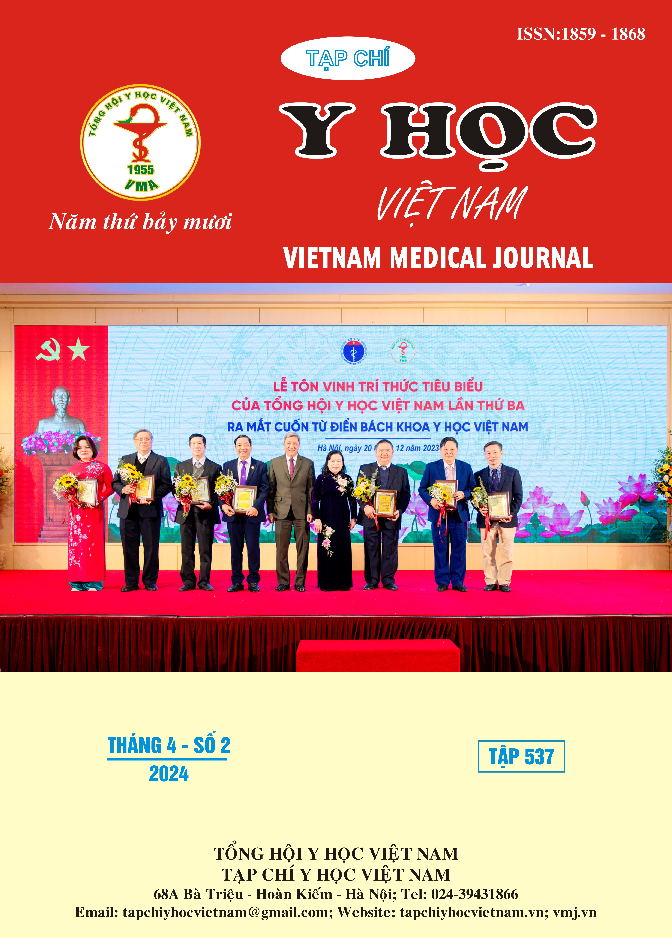CLINICAL AND LABORATORY CHARACTORISTIC OF COMPLETE URETERAL DUPLICATION IN CHILDREN WHO RECEIVED CONSERVATIVE SURGERY AT THE NATIONAL CHILDREN'S HOSPITAL
Main Article Content
Abstract
Complete duplication of the renal collecting system is a common congenital anomaly in the pediatric urological system. Clinical symptoms are diverse but not specific. It is necessary to coordinate with imaging diagnostics to confirm diagnosis and monitor treatment. The surgical intervention is determined based on the morphological characteristics of each patient's pathology. Conservative surgery to treat complete ureteral duplication is receiving increasing attention and research and evaluation Objective: Describe clinical and laboratory charactoristic of complete ureteral duplication in children who received conservative surgery at the national children's hospital. Subjects and Methods: A retrospective analysis of 62 patients who underwent conservative surgery for complete duplication of the renal collecting system at the National Children's Hospital from January 2018 to June 2022. Results: The male-to-female ratio was 1:2.5. 22.6% did not have clinical symptoms, the most common clinical presentation was urinary tract infection, accounting for 56.5%. In this study, the main injury being dilation of the upper renal unit 95.2%, 24.2% had vesicoureteral reflux. Conclusion: The most common clinical symptom is urinary tract infection. Many cases require surgical intervention before symptoms appear. 95.2% dilation of the upper renal.
Article Details
Keywords
complete ureteral duplication
References
2. Van Savage JG, Mesrobian HG. The impact of prenatal sonography on the morbidity and outcome of patients with renal duplication anomalies. J Urol. 1995;153(3):768-770.
3. Abdelhalim A, Chamberlin JD, Truong H, et al. Ipsilateral ureteroureterostomy for ureteral duplication anomalies: predictors of adverse outcomes. J Pediatr Urol. 2019;15(5):468.e1-468.e6. doi:10.1016/j.jpurol.2019.05.016
4. Đỗ Mạnh Hùng. Đánh giá kết quả phẫu thuật nội soi qua phúc mạc cắt đơn vị thận trên mất chức năng trong điều trị thận niệu quản đôi hoàn toàn ở trẻ em. Tạp chí Y học Việt Nam. 2021;502.
5. Bùi Hoàng Thảo. Nghiên cứu chẩn đoán và điều trị phẫu thuật thận niệu quản đôi ở trẻ em tại khoa phẫu thuật nhi BV Việt đức. Luận văn bảo vệ thạc sĩ y học. 2014; 50-80
6. Nguyễn Thanh Quang, Lê Anh Tuấn, Nguyễn Thanh Liêm. Kết quả điều trị thận niệu quản đôi bằng phương pháp nối niệu quản niệu quản có nội soi sau phúc mạc sử dụng 1 trocar hỗ trợ. Tạp chí Y học Việt Nam. 137:16-23.
7. Mohamed Abou El-Ghar HRea. Diagnosing urinary tract abnormalities: intravenous urography or CT urography? Reports in Medical Imaging. 2014;1(13):55-63.
8. Riccabona M, Simbrunner J, Ring E, Ruppert-Kohlmayr A, Ebner F, Fotter R. Feasibility of MR urography in neonates and infants with anomalies of the upper urinary tract. Eur Radiol. 2002;12(6):1442-1450.


